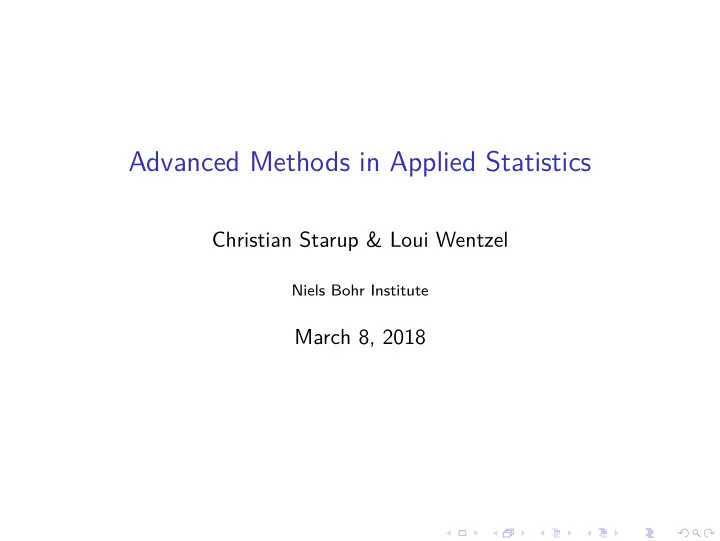

Advanced Methods in Applied Statistics Christian Starup & Loui Wentzel Niels Bohr Institute March 8, 2018
Journal Article https://doi.org/10.1093/bioinformatics/btw438
Problem Given a dataset where one needs to calculate several or many p-values. Should one account for a possible correlation between data variables?
No Correlation solution If the P-values are not correlated, then according to H 0 the distribution of each P-value should be uniform, and the product of P-values should then be drawn from the distribution of N products of uniform numbers: � � ( − 1) N − 1 ( N − 1)! · ln( u ) N − 1 du P = (1) 0 This is equivalent to a χ 2 -test with 2 k degrees of freedom called Fishers Method: N � Ψ = − 2 log( P i ) (2) i =1 � ∞ χ 2 P = φ 2 k (Ψ) = 2 k ( x ) dx (3) Ψ
Correlation solution However, if the data is correlated, we can’t assume a uniform distribution of P-values. Brown therefore expanded Fisher’s method to include a re-scaling factor, c, such that Ψ ∼ c χ 2 2 f . f = E [Ψ] 2 c = Var [Ψ] 2 E [Ψ] = k � Var [Ψ] = 4 k + 2 cov ( W i , W j ) var [Ψ] f i < j With W i = − 2 log( P i ), E [Ψ] = 2 k (assuming a χ 2 distribution), k is the Fisher’s DoF and f the re-scaled Brown’s DoF. The combined P-value is then: P combined = 1 − Φ 2 f (Ψ / c ) with Ψ = � W i , Φ 2 k being the cumulative distribution function of χ 2 2 f .
Correlation solution continued The articles contribution to Browns’ method is to calculate the covariance matrix by an empirical approximation, thereby the Empirical Brown’s method (EBM): cov ( W i , W j ) ≈ cov ( w i , w j ) w i = − 2 log(1 − F ( − → x i )) Kost’s method uses another approach to calculate the covariance: cov ( W i , W j ) ≈ 3 . 263 ρ ij + 0 . 710 ρ 2 ij + 0 . 027 ρ 3 ij The EBM is a non-parametric approach, where F ( − → x i ) is the right-sided empirical cumulative distribution function.
Simulating data Parameters were µ i = 0, a = 0 . 8, n = 4. b j was randomly sampled from [ − 0 . 5; 0 . 5]. Each sample had 200 entries. 1 . . . . . . b 2 b j b n b 2 1 . . . a . . . a . . . . ... ... . . . . . . . . M = (4) . . . 1 . . . b j a a . . . . ... ... . . . . . . . . b n a . . . a . . . 1 From any sample � y drawn from this distribution, n -dimensional uniform noise from [ − 1; 1] was added: y + ξ� � x = � U (5) They draw numbers from one axis on the multivariate normal distribution (axis 1 with correlations b j to the others) and test the correlation to the other axes using Pearsons correlation test.
Ground Truth P-values To test the different tests against correlated data, it should yield the same results as if the data was uncorrelated. ◮ Shuffle � y 1 ◮ Calculate Ψ ∗ as earlier ◮ Repeat M times The ground truth P-value is then � M m =1 I (Ψ ∗ m ≥ Ψ) P ground = (6) M Notice this gives a resolution in the ground truth P-value by 1 / M .
Performance results as a function of Signal to Noise ratio
Recommend
More recommend